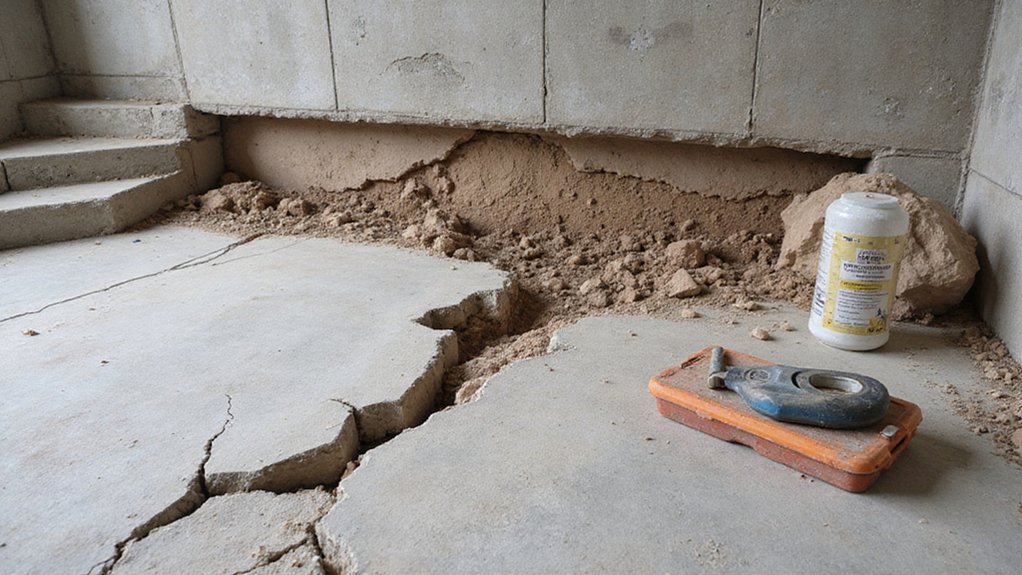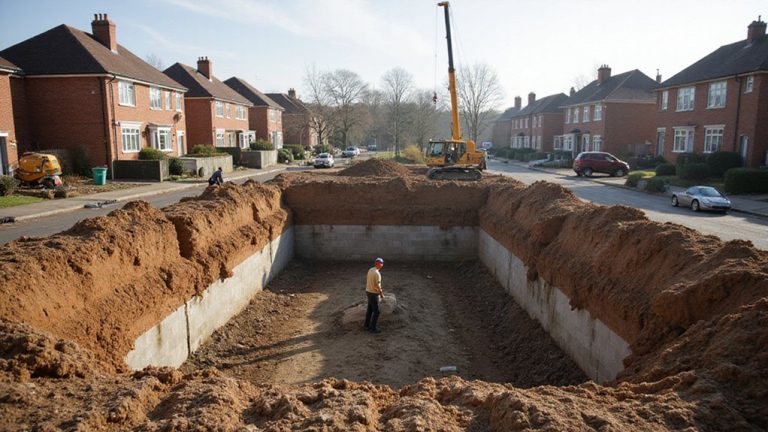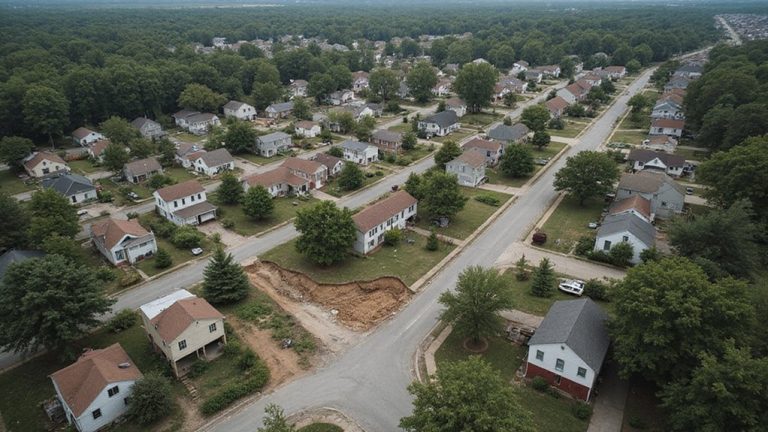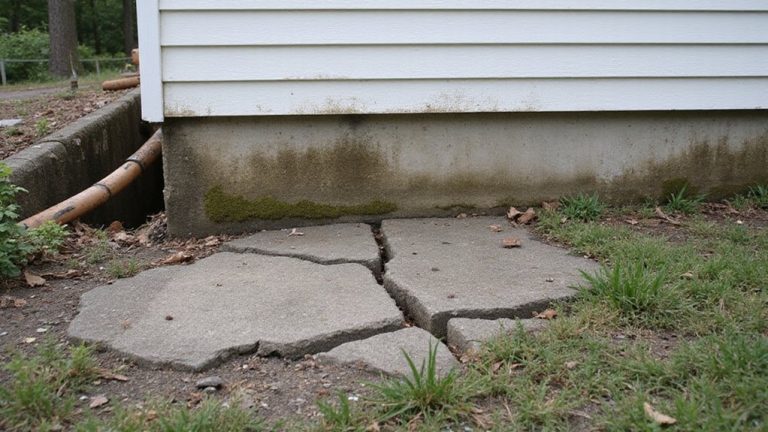Foundation cracks can be a serious issue for homeowners, often signaling deeper structural problems. You’ll want to identify the type and severity of the cracks to determine the appropriate repair method. While some fixes, like waterproofing or crack sealing, may be relatively straightforward, more complex solutions like foundation reinforcement or soil stabilization may be necessary. Understanding the underlying causes – whether it’s expansive soil, poor drainage, or construction defects – is key to preventing further damage and restoring your home’s stability.
Common Causes of Foundation Cracks
If your home’s foundation has developed cracks, you’re likely concerned about the potential issues and costs involved.
Common causes include expansive soil conditions, where soil expands and contracts as it becomes wet and dry. This can exert pressure on your foundation, leading to cracks.
Improperly graded drainage around your home can also contribute to foundation issues, as excess water accumulation can destabilize the soil.
Understanding the root causes of your foundation problems is the first step toward finding an effective solution and protecting your home’s structural integrity.
Diagonal and horizontal cracks can potentially grow and become costly to repair if not addressed promptly.
Identifying Foundation Cracks
One of the first steps in addressing foundation cracks is properly identifying the type and severity of the damage. Cracks can be caused by soil expansion or drainage issues, which can worsen over time if not addressed. Horizontal wall cracks can indicate significant foundation stress from soil pressure and moisture. Look for horizontal cracks, vertical cracks, stair-step cracks, and cracks around windows and doors. Inspect the size, location, and pattern of the cracks to determine their cause and the appropriate repair method. Addressing foundation cracks early can prevent further structural damage and costly repairs down the line. Don’t hesitate to consult a professional if you’re unsure about the nature of the cracks.
Evaluating the Severity of Foundation Cracks
Evaluating the severity of foundation cracks is crucial for determining the appropriate course of action. Carefully examine the width of the cracks – hairline cracks are often less serious than wider ones.
Determine the depth of the cracks as well, as deeper ones may signal more significant structural issues. Don’t panic, though – many foundation cracks are repairable with the right approach.
Stay calm, and work closely with a professional to fully assess the situation and develop an effective solution. With the right knowledge and care, you can address the problem and protect your home’s stability.
Waterproofing and Foundation Repairs
Once you’ve assessed the severity of the foundation cracks, it’s time to ponder waterproofing and foundation repairs. Basement waterproofing is pivotal to prevent further moisture intrusion and structural damage.
Structural waterproofing, on the other hand, addresses the root causes of cracks and shifting foundations. A professional contractor can help determine the best course of action, whether it’s sealing cracks, reinforcing the foundation, or even shoring up the structure.
These repairs may seem formidable, but they’re necessary to safeguard your home’s stability and value. With the right approach, you can restore your peace of mind.
Soil Stabilization Techniques
Alongside waterproofing measures, you may need to investigate soil stabilization techniques to address the underlying foundation issues. Proper soil moisture management is vital, as fluctuating moisture levels can cause the soil to expand and contract, leading to foundation cracks.
Ground stabilization methods, such as chemical grouting or soil compaction, can help solidify the soil and prevent further movement. These techniques can be effective in stabilizing the foundation and preventing future damage. By addressing the root cause of the problem, you can guarantee a more durable and long-lasting solution for your home’s foundation.
Reinforcing the Foundation
If your home’s foundation has sustained significant cracks or damage, you may need to contemplate reinforcing the foundation to prevent further issues.
Concrete underpinning: This technique involves adding new concrete supports beneath the existing foundation to stabilize and strengthen it. This can be an effective solution for addressing severe foundation problems.
Foundation reinforcement: This may involve installing steel beams, brackets, or other structural supports to reinforce the foundation and distribute the home’s weight more evenly. This can help prevent further cracking and deterioration.
Applying epoxy or polyurethane injections: These materials can be injected into cracks to seal and stabilize the foundation, providing a cost-effective reinforcement solution.
Addressing Improper Construction Issues
Sometimes, improper construction can lead to foundation cracks and other structural issues. One common problem is improper excavation techniques, which can undermine the soil’s stability.
Another issue is inadequate soil preparation, where the ground isn’t properly compacted or leveled before the foundation is laid. These errors can cause the foundation to settle unevenly, leading to cracks and other problems down the line.
If you suspect your foundation was improperly constructed, it’s essential to address the issue promptly to prevent further damage. A professional inspection can help identify the root cause and recommend the best solution.
Maintaining a Healthy Foundation
Maintaining a healthy foundation is essential for the long-term stability and worth of your home. To guarantee your foundation remains in top condition, consider these crucial steps:
- Prioritize moisture control: Proper drainage and waterproofing are indispensable to prevent water infiltration, which can lead to foundation cracks and deterioration over time.
- Maintain soil compaction: Ensure the soil around your home is well-compacted, as inadequate soil support can cause your foundation to shift and crack.
- Address issues promptly: If you notice any signs of foundation problems, such as cracks or unevenness, don’t hesitate to have them evaluated and addressed by a professional.
Frequently Asked Questions
Can Foundation Cracks Be Prevented Entirely?
While foundation cracks can’t be entirely prevented, you can take steps to minimize them. Proper drainage systems and soil stabilization techniques can help protect your home’s foundation and preserve its structural integrity.
How Often Should a Foundation Be Inspected?
You should schedule routine inspections of your foundation to catch any issues early. Aim for a professional inspection at least once every 2-3 years to guarantee your home’s stability and safety.
What Is the Cost Range for Foundation Repair?
Typical repair costs range from $2,000 to $20,000, depending on the extent of the damage. Professional inspection services can identify issues early, helping you address them before they become more expensive to fix.
Can Homeowners DIY Foundation Crack Repairs?
Can homeowners DIY foundation crack repairs? While a proper foundation inspection is key, experienced DIYers may be able to tackle timely crack repairs themselves, saving money and feeling a sense of accomplishment in caring for their home.
How Do I Know if My Foundation Needs Replacement?
If you notice signs of foundation settlement or symptoms of foundation failure, it’s time to get a professional assessment. They can determine if your foundation needs replacement to keep your home secure and your family safe.



